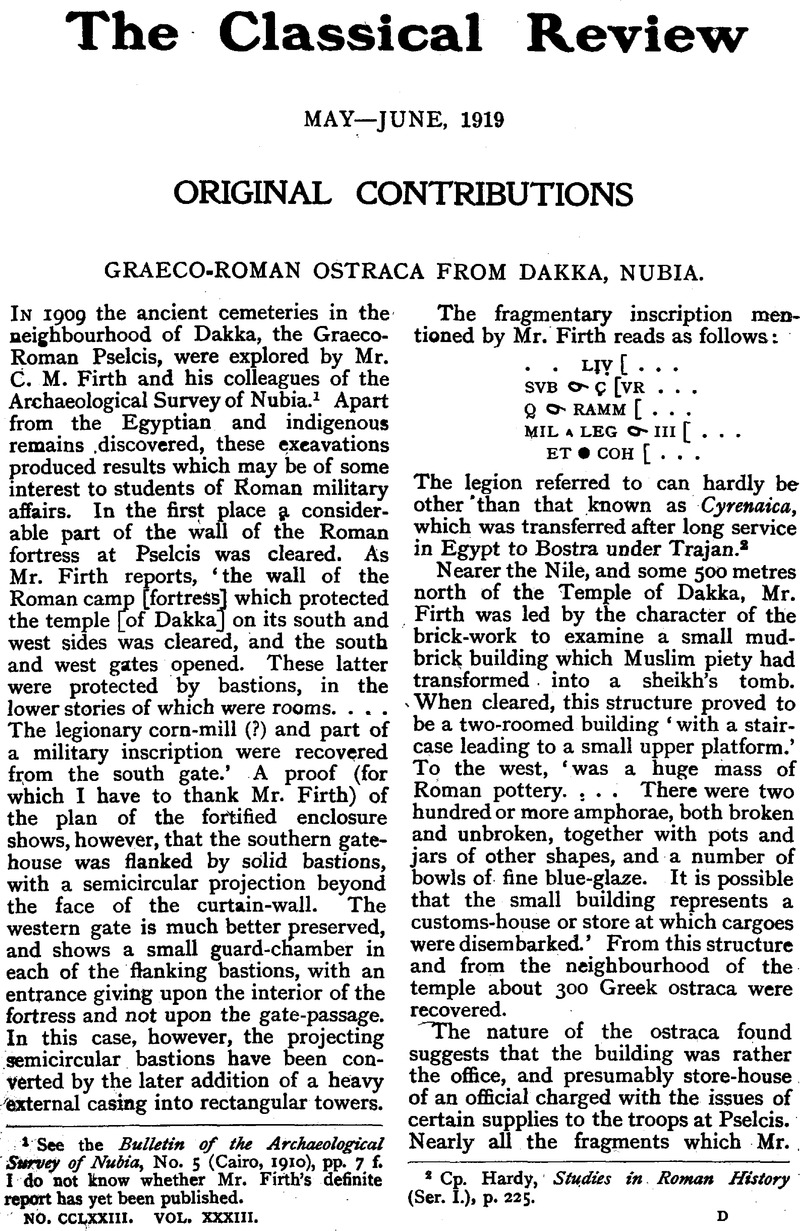Article contents
Graeco-Roman Ostraca From Dakka, Nubia
Published online by Cambridge University Press: 27 October 2009
Abstract

- Type
- Original Contributions
- Information
- Copyright
- Copyright © The Classical Association 1919
References
page 49 note 1 See the Bulletin of the Archaeological Survey of Nubia, No. 5 (Cairo, 1910), pp. 7 fGoogle Scholar. I do not know whether Mr. Firth's definite report has yet been published.
page 49 note 2 Cp. Hardy, , Studies in Roman History (Sen I.), p. 225.Google Scholar
page 50 note 1 Neu entdeckte Denkmäler von Nubien, pls. viii., ix.
page 50 note 2 Ap. Gau op. cit. pp. 18–20.
page 50 note 3 C. I. G., III. 5109. 1–37.
page 50 note 4 Griechische Ostraka II., Nos. 1128–1146. Wilcken's conjecture that 1265 came from Dakkeh seems to be confirmed by the reappearance of Petronius the cibariator in the present series.
page 50 note 5 Milne, , Hist, of Egypt under Rom. Ruĺe, p. 23.Google Scholar
page 50 note 6 What is meant by ![]() which Sagittarius holds in his right hand (Hipparchus, ad Phaen. I. 16 ap. Migne, P. G. XIX. 1037 A) is not clear: Sophocles doubtfully suggests ‘club.’
which Sagittarius holds in his right hand (Hipparchus, ad Phaen. I. 16 ap. Migne, P. G. XIX. 1037 A) is not clear: Sophocles doubtfully suggests ‘club.’
page 50 note 7 Cp. Bates, Rock Inscrs. near Dakka (in Bull. of the Arch. Survey of Nubia, No. 5), Station 1, Nos. 6—7 ![]() . Also P. Hamb. 39. p. 175; B. G. U. 344, 14; and Lesquier, L'Armée Romaine, p. 229, and App. I., Inscr. 13 (=Maspero, Ann. du Service des Ant. IX. 267 ff.).
. Also P. Hamb. 39. p. 175; B. G. U. 344, 14; and Lesquier, L'Armée Romaine, p. 229, and App. I., Inscr. 13 (=Maspero, Ann. du Service des Ant. IX. 267 ff.).
page 50 note 8 Cp. Wilcken's Nos. 1130 ff.
page 50 note 9 Cp; Eph. Epigr. VII. 463; P. Oxyr. 1652 (unpublished); B.G.U. 696, 14, 30. and 827 verso.
page 51 note 1 The word has not previously occurred except in Wilcken's Nos. 1142, 1265.
page 51 note 2 Ib.
page 51 note 3 Rations were issued to troops; but unlike the modern rations their value was deducted from the soldiers' pay. John the Baptist (St. Luke iii. 14) may therefore have had reason to advise the soldiers to be content with their rations (![]() ).
).
page 51 note 4 In Wilcken's No. 1129, 1. 4, ![]() is probably to be read. Presumably it was a vessel of standard shape and size manufactured at Coptos (the modern Kift, some distance north of Luxor).
is probably to be read. Presumably it was a vessel of standard shape and size manufactured at Coptos (the modern Kift, some distance north of Luxor).
page 51 note 5 See Wilcken, I., p. 759.
page 51 note 6 I., p. 764; cp. No. 1265 (in No. 1166 κολ perhaps = κολφώνιον). No doubt the term originally denoted a peculiar type of wine vessel exported from Colophon; but this restricted sense is quite absent in this ostraca. An exact analogy is provided by the term ![]() in an anecdote concerning the Egyptian monk Sisoes (see Apophth. Pair.: Sisoes VIII.): cp. Wilcken I. 765.
in an anecdote concerning the Egyptian monk Sisoes (see Apophth. Pair.: Sisoes VIII.): cp. Wilcken I. 765.
page 51 note 7 Cp. Wilcken, Nos. 1142, 1265.
page 51 note 8 The persons named in this and the earlier Dakka series are often the same. Presumably therefore Wilcken's dating (I. 705) for the earlier series applies equally to the later.
page 51 note 9 See Wilcken, I., p. 83: B.G.U., 834, 24.
page 51 note 10 See Wilcken, I., p. 83, Nos. 1151; 1132.
page 51 note 11 For the significance of this, see Wilcken, I. 128.
- 1
- Cited by


